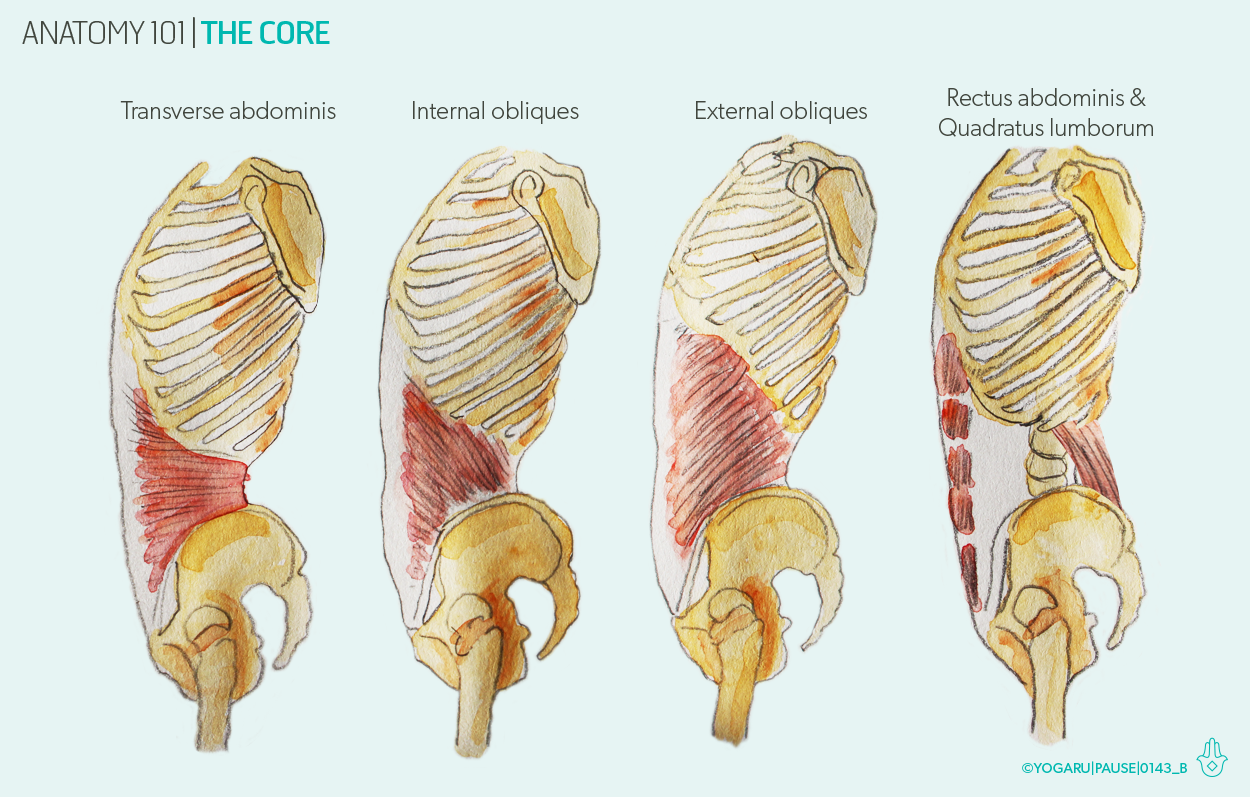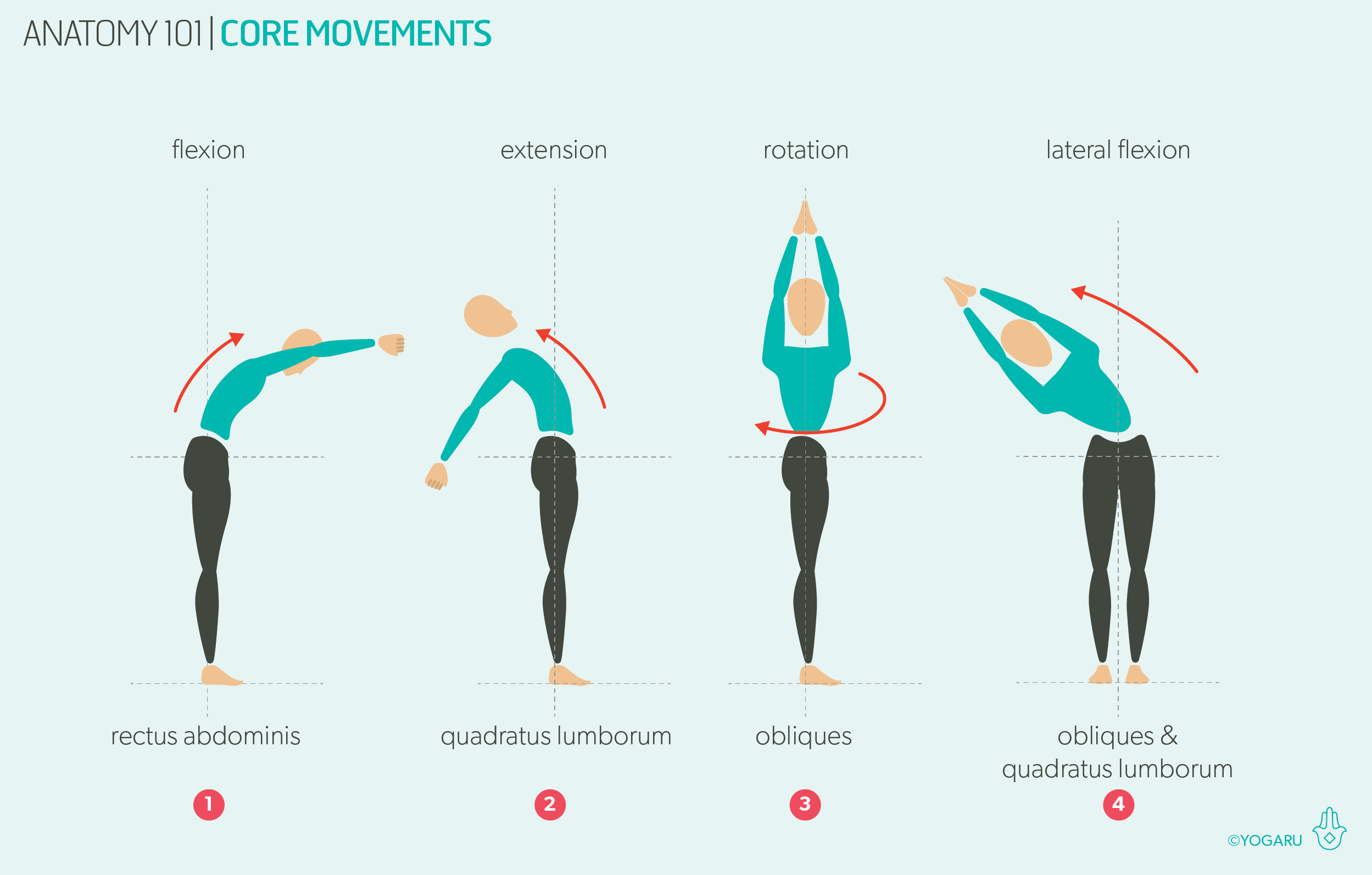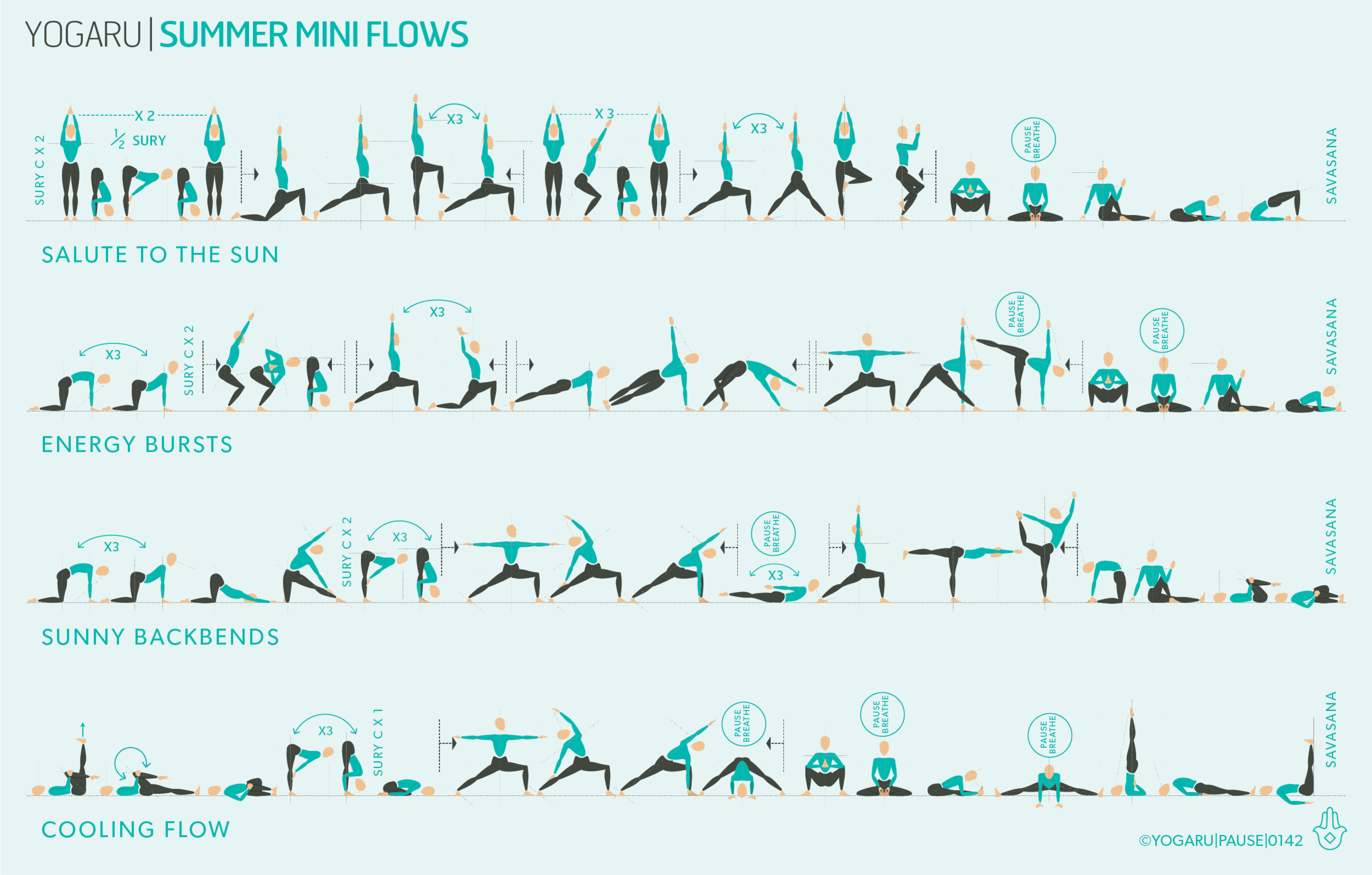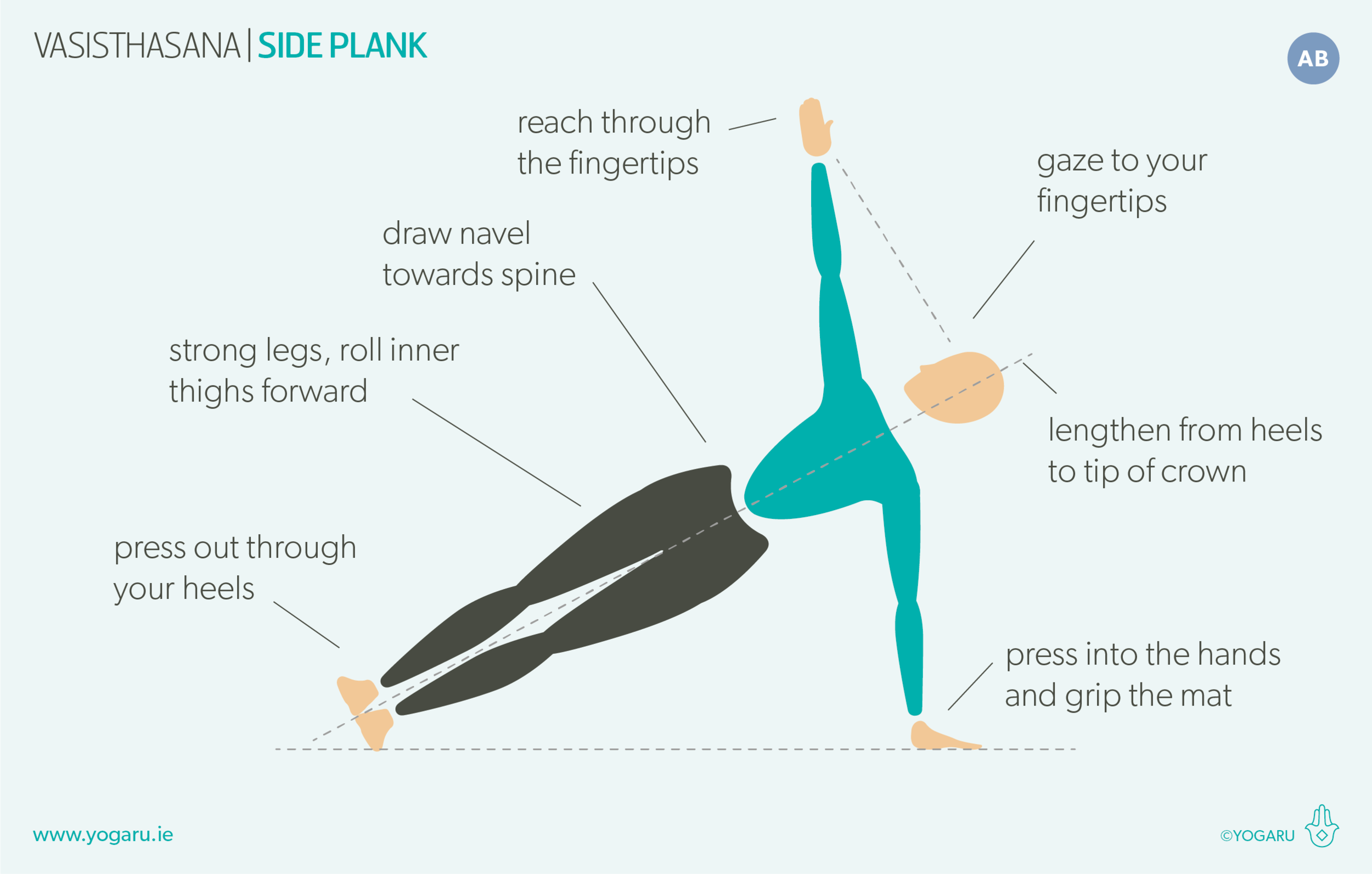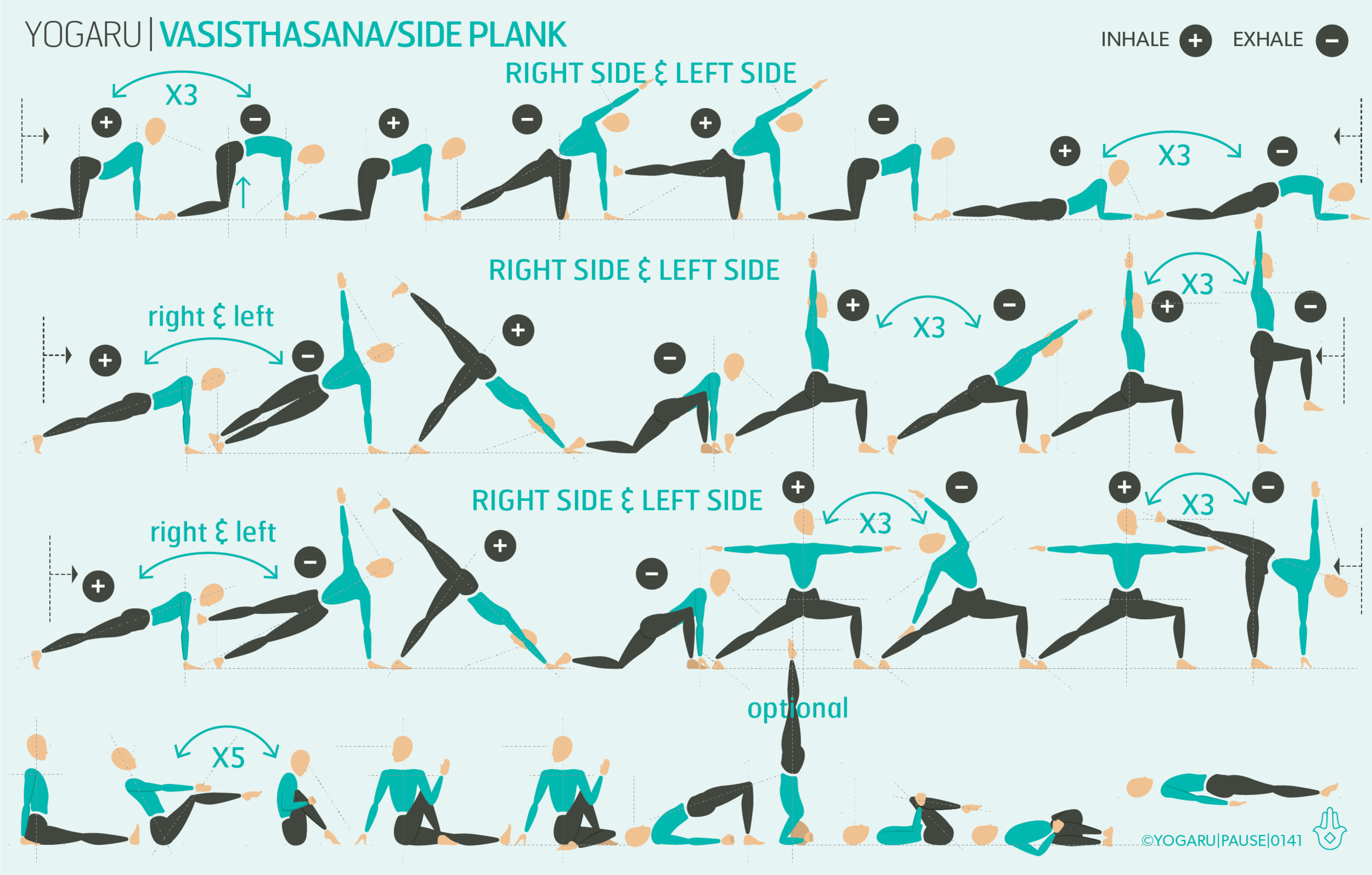THE CORE OF THE BODY
The abdominal muscles, often referred to as the ‘core’, are a group of muscles located between the ribs and the pelvis. Their job is to support the spine against gravity, contain the organs of the trunk and facilitate movement. The core is also linked to the health of our spine. They work together with the muscles of the lower back to protect the spine and move it in flexion and extension. When the core is weak the back needs to work harder to hold us up. When the core is tight or overworked it pulls the pelvis into a posterior backwards tilt, puts additional strain on the lumbar spine, curls the shoulders forward and rounds the upper back.
THE STRUCTURE OF THE CORE
In working with the core it is important to visualise it as a full 360 degree network of muscles wrapping around your whole trunk. The core has a back, the quadratus lumborum, a base, the pelvic floor, and a top, the diaphragm. The psoas, which is considered ‘the core of the core’, is one of the biggest muscles of the body, and is responsible for hip flexion and movement. It is the only muscle that connects the upper and lower body, and is vital for all movement. For the purpose of this exploration we will stick with the four front abdominal muscles and the quadratus lumborum which connects the back of the hips to the back of the ribs.
THE MOVEMENTS OF THE CORE
Below there is an illustration of the movements of the core:
Flexion – where the core contracts forward.
Extension – where the core expands back.
Rotation – where the core twists to the right or left side.
Lateral flexion – where the core bends to the right or left side.
THE MUSCLES OF THE CORE
Starting with the deepest muscle:
Transverse abdominis are not considered a movement muscle, their action is compression and work like a containment sheaths that wrap around the core like a corset to support the organs, assist in posture and cinch the waist in.
Internal obliques are found either side of the body and run from the hips to the ribs diagonally and are responsible for lateral flexion, rotation and the side curves of the waistline.
External obliques are also found either side of the body and run from the ribs to the hips, crossing diagonally with the internal obliques and are also responsible for lateral flexion, rotation and the side curves of the waistline.
Rectus abdominis are the outermost layer of muscle at the front of the body and run from the pubis to the bottom of the sternum and are responsible for flexion of the spine into forward folds, stabilise the pelvis and shape the front of the body.
Quadratus lumborum is located at the back of the body and runs from the hips to the lower ribs, it does the opposite to the rectus abdominis to extend the spine into backbends when working as a pair and assist in lateral flexion when working individually.
THE OBLIQUES IN ROTATION & LATERAL FLEXION
Rotation (twist) and lateral flexion (sider bends) are a bit more complicated when it comes to which muscles are stretching and contracting. When we twist to the right the right side internal obliques contract and the right side external obliques stretch, while the left side internal obliques stretch and the left side external obliques contract. When we take a side bends to the right the right side internal obliques contract and the right side external obliques contract, while on the left side the left side internal obliques stretch and the left side external obliques stretch.
EXPLORING THE CORE IN YOUR PRACTICE
This sequence brings your full attention to the 360 wrap of your core in action. Remember that muscles work in tandem to each other so when you feel a stretch on one side the other side is strengthening. I have highlighted the five muscle actions of the core - four movements of the core and an additional action of compression. The sequence is designed to build a three dimensional awareness of the core.
ALIGNMENT CUES
This sequence will bring you through the five muscle actions of the core – flexion, extension, rotation, lateral flexion and compression. A selection of asana are numbered to highlight sample poses from each muscle action to give you a better understanding and the opportunity to experience the sensations of the core in action ad you practise. Below are the asanas which are highlighted in the sequence and some cues to help you tap into where you will feel the five muscle actions of the core:
1 – Flexion - draw your navel towards your spine and come into flexion on an exhale. Feel the rectus abdominis muscles at the front of the core contract .
Marjaryasana/Cat with the knees slightly lifted off the ground; Naraviralasana/Sphinx with hips lifted; Phalakasana/Plank Pose with knee to elbow; Tadasana/Mountain with single knee lifted.
2 – Extension - allow the inhale to expand your front core as the back core contracts. Feel the quadrates lumborum muscles at the back of the spine contract.
Bitilasana/Cow; reverse table top; Setu Bandha Sarvangasana/Bridge.
3 – Rotation - lengthen on an inhale and come into your twist on an exhale. Feel the diagonal pairs of the obliques muscles on the side of the body contract and stretch.
Parivrtta Ashta Chandrasana/Revolved Eight Crescent Moon; Marichyasana III/Marichi III.
4 – Lateral flexion - lift up out of the spine and lengthen through your whole side bend. Feel the obliques and quadratus lumborum muscles contract on the bending side and stretch on the opposite side.
Parighasana/Gate; Vasisthasana/Side Plank.
5 – Compression - cinch your 360 waist in on an exhale. Feel the muscles of the transverse abdominis contract.
Phalakasana/Plank Pose; Ashva Sanchalanasana/Galloping Horse; reverse Galloping Horse.
To save the images for personal use click and hold down the image until the ‘save image’ option appears; on Mac hold down ‘control’ and click the image to get the option box; on PC right click on the image to get the option box. Scroll down in the ‘option box’ and click ‘save image’.
Ruth Delahunty Yogaru


